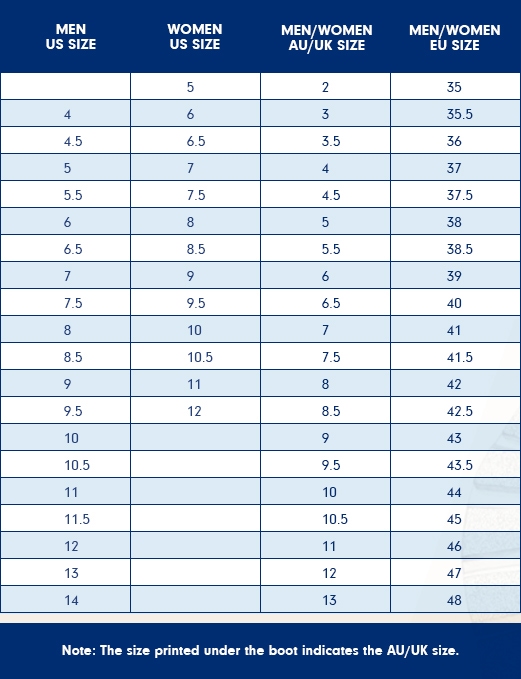AU to US Shoe Size Conversion Guide for Busy Parents!
Hello there, super moms and dads! Are you ever confounded by the maze of children’s shoe sizes when selecting the perfect fit for your little ones? Well, fret not! This colorful guide is your trusty sidekick in the valiant quest of converting Australian (AU) shoe sizes to United States (US) sizes for your kiddos.
Shopping for kids’ shoes, especially online, can sometimes be as challenging as convincing a toddler to eat their veggies. But with our help, you’ll be a shoe size wizard faster than you can say, “Cinderella”! So, grab your measuring tape, rally the kidlets, and let’s step into the fun world of shoe size conversion!
Understanding AU Kids’ Shoe Sizes
Before we leap over to the US sizes, let’s get a handle on what AU shoe sizing looks like. Australian children’s shoe sizes are measured in millimeters and are often similar to UK sizes, which means if you’ve been shopping from British brands, you’re off to a good start!
Why Perfect Fit Matters for Your Munchkins
The right fit is absolutely vital when it comes to your child’s footwear – it’s not just about comfort, it’s also about supporting healthy foot development. Ill-fitting shoes can lead to blisters, calluses, and even structural problems in the long run. So, let’s make sure those tiny toes have the space to wiggle and grow!
Converting AU to US Kids’ Shoe Sizes
Conversion between Australian and US kids’ shoe sizes can be as simple as consulting a size chart – which we will provide shortly – or it might require a little bit of math. Typically, AU kids’ sizes are 2 sizes smaller than US kids’ sizes. So if your child is a size 10 in Australia, you’ll be looking for a size 12 in the US.
Step-by-Step Guide to Measuring Your Child’s Feet
Before we dive into the essential shoe size charts, let’s ensure we have the right measurement. Here’s how:
- Place a piece of blank paper on a flat surface against a wall.
- Have your child stand on the paper with their heel against the wall and weight distributed evenly.
- Mark the longest part of their foot (from heel to the tip of the longest toe) on the paper.
- Measure the distance between the edge of the paper and the mark.
- Write this number down and compare with the size chart for an accurate measurement.
The Ultimate AU to US Kids’ Shoe Size Chart
Now that we have our precise measurement, take a look at our conversion chart below. This chart will help you transform those AU sizes into US sizes in a snap.
Pro Shopping Tips for Parents
While our chart is a fantastic tool, remember that shoe sizes can vary slightly among different brands. When possible, check the brand’s specific size guide. Also, consider the sock thickness your child will usually be wearing with the new shoes, as this can affect the fit.
Keep in mind, the need for shoe size updates does not march to a regular drumbeat. Check your child’s shoe size often as they can have unexpected growth spurts!
Remember, converting shoe sizes doesn’t have to be a chore; it can be part of the fun of shopping and finding that perfect pair. We hope this guide adds a spring to your step and a sparkle to your child’s eye when you unveil their impeccably fitting new shoes. Stay tuned for more handy tips to ensure that your little tyke steps out in comfort and style.

5 Essential Things Parents Should Know About AU to US Shoe Size Conversion
1. AU and US Sizes Aren’t Always Perfectly Aligned
Even though there’s a general rule of thumb for converting AU to US kids’ shoe sizes, it’s not an exact science. While the majority of AU sizes are about two sizes smaller than their US counterparts, this can fluctuate between brands. Always double-check with the specific brand you are purchasing from to ensure the best fit.
2. Account for Growth Spurts
Children’s feet grow faster than a bamboo plant in a time-lapse video! It’s wise to account for sudden growth when choosing sizes. Consider opting for a half-size larger to give them room for growth, ensuring the shoes last longer than a season, and offering your wallet a small respite!
3. The Importance of Regular Size Checks
Be vigilant – your child’s feet can grow before your very eyes! Regular foot measurements, ideally every two to three months, can prevent your child from wearing too-small shoes, which can have detrimental effects on their delightful little feet.
4. Wide Feet and Special Considerations
Does your child have wide feet or need orthopedic inserts? AU to US conversion charts typically cater to standard sizes, so you’ll want to take these special considerations into account. In many cases, width and supplemental arch support can affect overall fit, so be thorough when researching sizes.
5. Online Shopping Strategies
In the digital shopping arena, the fit is the final frontier. Look for online retailers with good return policies, detailed sizing instructions, and customer service that’s as reliable as your morning caffeine fix. This approach softens the blow if the size isn’t quite right the first time around.
Detailed Sizing Charts and Examples
Armed with a fresh foot measurement and considering the factors above, let’s dive into our detailed AU to US kids’ shoe size conversion chart:
| AU Size | Foot Length (mm) | US Size (approximate) |
|---|---|---|
| 5 | 132 | 7 |
| 6 | 140 | 8 |
| 7 | 145 | 9 |
| 8 | 153 | 10 |
Let’s look at an example. Say you’ve measured your child’s foot at 145mm. According to our chart, that’s an AU size 7. We then convert this to an approximate US size 9. Simple, right? But don’t put away that measuring tape yet!
Ensuring an excellent shoe-shopping outcome may mean you’ll need to check the chart every few months due to those pesky growth spurts we mentioned earlier. Keep this chart handy, keep your wits about you, and may the shoe-size force be with you!
Ready for more tips and tricks to make the parenting journey as smooth as a baby’s bottom? Bookmark this guide and share it with your parenting pals – together, let’s conquer the children’s shoe universe!
For more great articles please see here. For more information see here
Disclaimer
The articles available via our website provide general information only and we strongly urge readers to exercise caution and conduct their own thorough research and fact-checking. The information presented should not be taken as absolute truth, and, to the maximum extent permitted by law, we will not be held liable for any inaccuracies or errors in the content. It is essential for individuals to independently verify and validate the information before making any decisions or taking any actions based on the articles.




